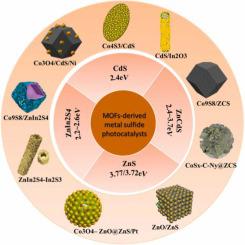Applied Catalysis A: General ( IF 4.7 ) Pub Date : 2023-08-22 , DOI: 10.1016/j.apcata.2023.119387
Yuping Tong , Yuxin Hou , Zhuo Zhang , Liang Yan , Xi Chen , Hailong Zhang , Xiao Wang , Yanqiang Li

|
Photocatalytic hydrogen evolution is an efficient strategy to convert solar energy into hydrogen energy, which is of significant importance to solve the issues of energies shortage and environmental pollution. Transition metal sulfides have been widely investigated owing to their high catalytic activity, appropriate band gap, and wide range of photo responsive capacity and low cost. At the same time, benefiting from their adjustable structure, high specific surface area and diverse metal centers, metal-organic frameworks (MOFs) are promising precursors to prepare transition metal sulfides. In this paper, recent progress of transition metal sulfide photocatalytic materials derived from MOFs for hydrogen evolution are summarized. The effects of metal centers, nanostructure and band gap of the metal sulfides on their photocatalytic hydrogen evolution efficiency are discussed and the proposed reaction mechanisms are summarized. In addition, the challenges and development direction in this area are proposed to provide new guidance for the progress of MOFs-derived metal sulfides photocatalysts.
中文翻译:

MOFs金属硫化物光催化析氢研究进展
光催化析氢是将太阳能转化为氢能的有效策略,对于解决能源短缺和环境污染问题具有重要意义。过渡金属硫化物由于其高催化活性、合适的带隙、广泛的光响应能力和低成本而受到广泛的研究。同时,金属有机骨架(MOF)凭借其可调节的结构、高比表面积和多样化的金属中心,是制备过渡金属硫化物的有前途的前体。本文综述了MOFs过渡金属硫化物光催化析氢材料的最新进展。金属中心的影响,讨论了金属硫化物的纳米结构和带隙对其光催化析氢效率的影响,并总结了所提出的反应机制。此外,还提出了该领域面临的挑战和发展方向,为MOFs衍生的金属硫化物光催化剂的进展提供新的指导。

































 京公网安备 11010802027423号
京公网安备 11010802027423号